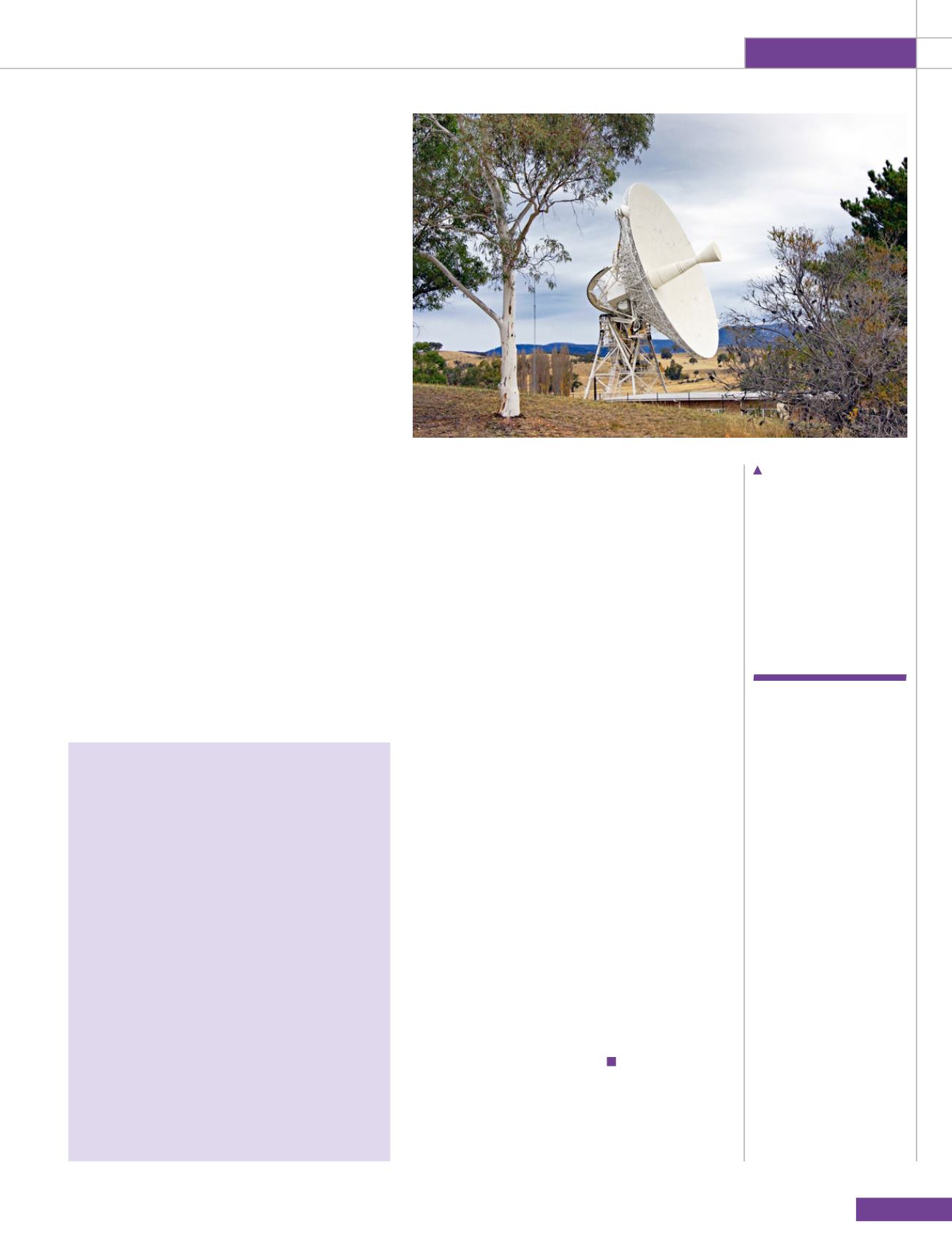
ROOM
101
Space Lounge
Australia, with three stations established south of
the city - Tidbinbilla (for the Deep Space Network),
Orroral Valley (for the Satellite Tracking and Data
Acquisition Network station) and Honeysuckle Creek
(for the Manned Space Flight Network).
Tidbinbilla and Honeysuckle Creek jointly
participated in the Apollo programme, playing
particularly critical roles in the Apollo 11 and 13
missions. Honeysuckle Creek actually brought
the world the television images of Neil Armstrong
stepping onto the lunar surface, before the rest
of the Apollo 11 television broadcast was relayed
via Parkes.
Today, as the Canberra Deep Space
Communication Complex, only the Tidbinbilla
station remains in operation, playing a crucial role
in planetary exploration. While the tracking station
itself is not open to the public, the facility has an
excellent Visitors’ Centre, with displays covering
the history of the station in the wider context of
planetary exploration.
The section on the Apollo missions includes
the largest lunar sample on public display
in Australia. The original antenna from the
Honeysuckle Creek tracking station, which
received the historic Apollo 11 broadcast, was
transported to Tidbinbilla after the station closed
in the early 1980s and can be seen near the
tracking station entrance. Finally retired from
operations in 2009, it was declared a Historic
Aerospace Site in 2010 by the American Institute
of Aeronautics and Astronautics.
Located 35 km southwest of Canberra, the
Canberra Deep Space Communication Complex is
only accessible by car, a 45-minute drive through
scenic forest, farmland and a nature reserve. Have
lunch at the Moon Rock Café and make a day of your
visit by venturing on from Tidbinbilla to the sites of
the former Honeysuckle Creek and Orroral Valley
stations (now both included on the Heritage Register
of the Australian Capital Territory). Although little
remains at these sites now but concrete footings,
both have some interpretive signage outlining
their NASA histories. For information on visiting
Tidbinbilla go to:www.cdscc.nasa.gov
For the adventurous with plenty of time, a
road trip travelling north from Perth could
take in ESA’s Deep Space Station at New Norcia
(140 km from Perth), the Western Australia
Space Centre (a commercial satellite tracking
facility) and NASA’s Mobile Laser Observatory,
both located at Dongara, about 400 km from
Perth. None of these sites, however, are open to
visitors without prior arrangement.
Travelling even further afield, the Carnarvon Space
and Technology Museum, located near the regional
hub of Carnarvon, 900 km from Perth, can be found
on the now-decommissioned site of Australia’s first
satellite Earth station (established in 1966). This
privately-run museum contains a variety of artefacts
from the former satellite station and the now-
demolished NASA tracking station nearby. Further
information on visiting this museum can be found at:
About the author
Kerrie Dougherty is an independent curator and space historian with
more than 30 years’ experience working in museums. She is a recognised
authority on Australian space history and has been involved in some
capacity with almost every space site mentioned in this article.
The historic dish from
Honeysuckle Creek
tracking station that
received the television
signals of Armstrong’s
first steps on the Moon,
now a heritage monument
at CDSCC.
Australia’s
national
capital region
was the home
of NASA’s
second
generation
of tracking
stations
Around Adelaide
From late August until November, host city
Adelaide will be focussed on space, with special
exhibitions at the State Library of South Australia
and the South Australian Museum. About 10
minutes’ walk from the congress venue, the State
Library will be presenting ‘Outback to Outer
Space: Woomera and space, 1955-1980’, a unique
exhibition drawing on the resources of the Library
and the National Archives of Australia, which will
tell the story of the space-related activities at the
Woomera Rocket Range, located in the northern
part of South Australia. Next door, the South
Australian Museum will be presenting a display
about the life of South-Australian-born astronaut
Dr Andrew SW Thomas, together with ‘Our Place in
Space’, an exhibition of Hubble Space Telescope-
inspired artwork from the Space Telescope
Science Institute. These exhibitions all form part
of the congress’ education, outreach and cultural
programme. Further details are available at: www.
slsa.sa.gov.au/site/page.cfm and
.
sa .gov.au/


